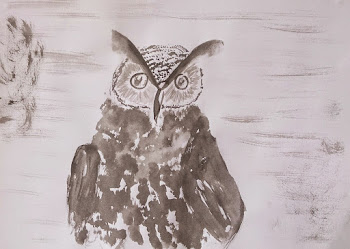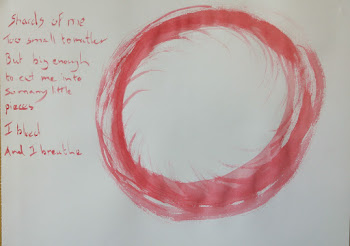Wednesday, 29 April 2015
Tuesday, 28 April 2015
New paper
I bought some handmade mulberry paper to try. Sumi is normally painted onto washi paper which is made from bamboo fibres. I thought the mulberry paper could be a good stand in. Unfortunately they didn't have plain white so I got light yellow. Painting on it proved quite different to watercolour paper, the fibres spread the ink in a different way. It may be good for pictures but it bleeds too much for clear writing. Perhaps I have to use a drier brush.


Monday, 27 April 2015
Sunday, 26 April 2015
The reason brushwork was so influential on metal work
The reason the tagane (chisels) are called the "iron brush" is carvings were closely related to ink paintings. This is not just some beautiful metaphor but as they were working in pre-photography times, ink paintings were the only common visual reference. Patrons would come in with a painting and want some part of that carved into a tzuba.
Saturday, 25 April 2015
Friday, 24 April 2015
Wednesday, 22 April 2015
Tuesday, 21 April 2015
Sunday, 19 April 2015
Enzo 23

Being who I am, I can do no other
This is a concept of determinism, all events from the beginning of creation leading to a decision influence that decision, therefore while it may not be fated(as in predetermined), there is only one decision which can be made
I'm quite pleased with the ink mixture, I used light black and dark red on the same brush giving me colour and tonal variety in one brush stroke.
Saturday, 18 April 2015
Thursday, 16 April 2015
Wednesday, 15 April 2015
Magpie culture

As a fairly extreme example of what I work with on a daily basis, this ring is perfect. The more, shinier, bigger approach to design can get very tiring.
One of the things which attracted me to the Japanese metalwork is the emphasis on balance, subtlety as well as the use of metals for their colour. There is a sensitive sophistication where all aspects are carefully considered and then skillfully executed.
Tuesday, 14 April 2015
Monday, 13 April 2015
Ted talk Helen Fisher
http://www.ted.com/talks/helen_fisher_tells_us_why_we_love_cheat#t-676214
A fascinating look at different love systems in the brain.
A fascinating look at different love systems in the brain.
Enzo 18
Saturday, 11 April 2015
Design concepts
The concept behind these sketches is to use a mild steel plate with silver wire inlay for the figures and a gold wire inlay connecting their hearts.
I want to show different kinds of relationships people form, the concept of the 'golden thread' which links people who love.
|
 |
| When two people are married but the man loves another as well |
 |
| Two men dancing a waltz, possibly the 'first dance' |
 |
| The marriage of two women |
 |
| The gold thread connecting a mother and her unborn child |
 |
| Within a couple, they turn or the world turns but they see only eachother |
Labels:
1st term 2015,
golden thread,
narrative,
relationships
Location:
(0.0 0.0)
Enzo 15
Labels:
100 Enzo,
1st term 2015,
enzo,
love,
sumi-e
Location:
(0.0 0.0)
Enzo 14
Labels:
100 Enzo,
1st term 2015,
enzo,
sumi-e
Location:
(0.0 0.0)
Tuesday, 7 April 2015
Monday, 6 April 2015
Narrative
I was making a particularly not so pretty ring at work the other day and realised that I spend much if my time telling other people's stories. Things which mean much to the customer but nothing to me. As such, I've become a good 'story teller', I can interpret the somebody's wants and desires and make them material, however I seldom ask what it is I want to say.
Posted via Blogaway
Posted via Blogaway
Stuff from instagram
Seems I've posted to instagram what I should have included here as well.
The lighthouse was more to see if I could engrave titanium and how successful the colouring would be.
The two fish were for my mom's birthday, she's a Pisces and goldfish or koi are featured often in sumi-e.
The silver piece is still a work in progress, a slightly deeper relief with no colouring to help define anything. I'm finding this one more difficult, although as I learn more I return to it. Tiaan suggested I use a lightly textured punch on the background to flatten and separate it from the carved flower so the next stage is making a punch.
Sunday, 5 April 2015
Kusozu
An interesting group of paintings from Japan between 1300 and 1900 are kosozu. Paintings showing the 9 stages of death and decomposition. Based in Buddhist belief that one should contemplate death and decomposition in order to overcome sensual desires and affectations. I found these images at http://strangeremains.com/2015/03/06/the-beauty-of-decomposition-in-japanese-watercolor/

















Subscribe to:
Comments (Atom)
































